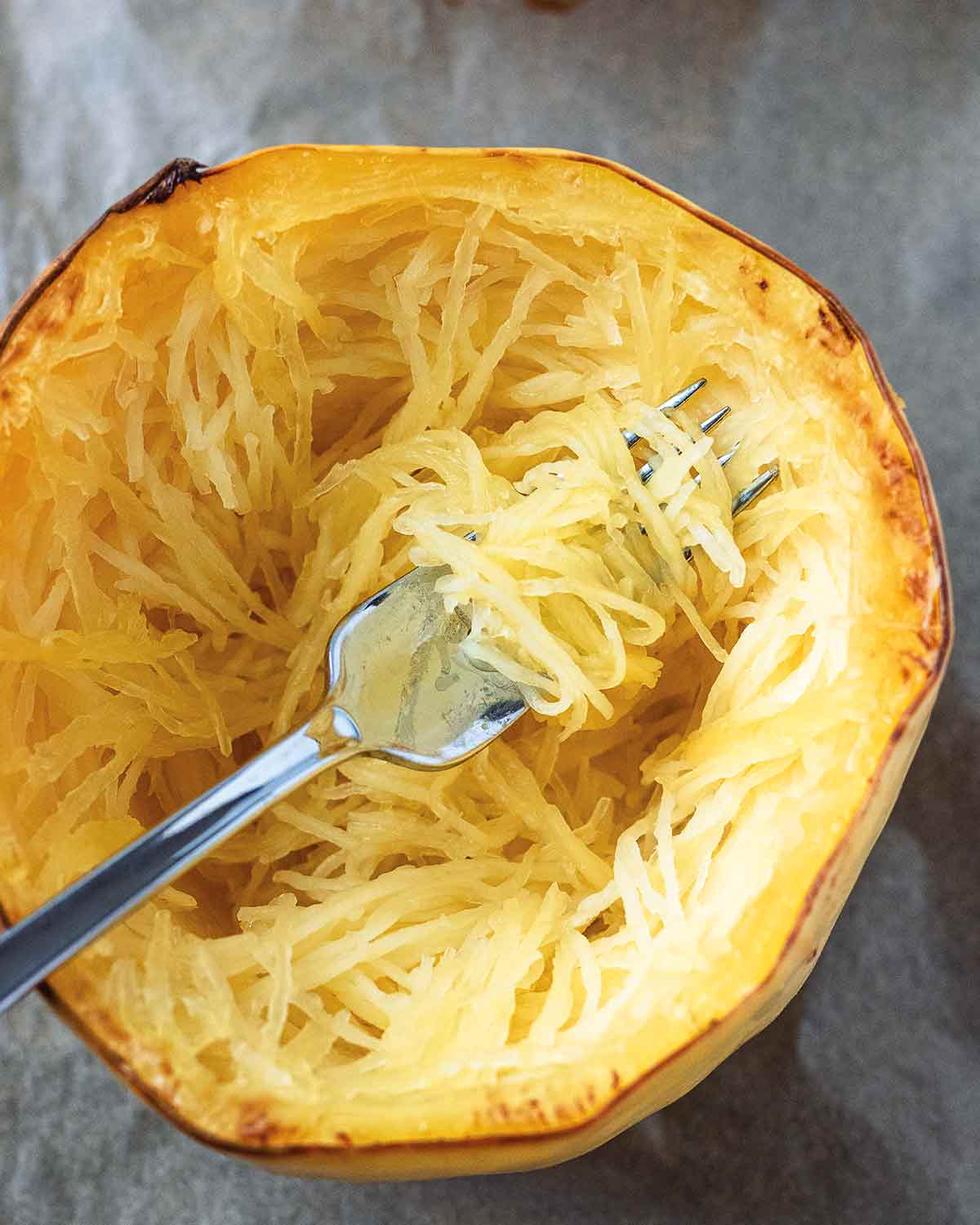
Roasted spaghetti squash noodles go perfectly with so many dishes. They are also delicious on their own with a bit of olive oil, salt, and pepper. I like to cut the squash in half horizontally around the middle, because it creates longer spaghetti-like strands. You can also cut it vertically to create boats; however, it may be harder to cut the squash open. I find that the method below creates the perfect spaghetti squash every time—never overcooked, mushy, or watery!–Mary Smith
How do I serve spaghetti squash?
Any way you want. Some folks like it simple with nothing but the olive oil, salt, and pepper. Others rely on a drizzle of brown butter. You can add a sprinkle of herb or ground cinnamon. Or you can top it with anything you would a baked potato. Or you can serve it in place of pasta with a proper marinara or Bolognese, keeping in mind the squash won’t taste like pasta but it will satiate without, as one of our testers perfectly explained, the carb coma.

Roasted Spaghetti Squash
Ingredients
- 1 large (about 2 pounds) spaghetti squash
- 2 teaspoons olive oil
- 1/4 teaspoon sea salt
Instructions
- Preheat the oven to 400°F (200°C). Line a rimmed baking sheet with parchment paper.
- Turn the squash on its side and carefully cut through the center of the squash to create 2 round halves (you want to cut right through the equator rather than lengthwise from end to end).
- Scoop out the seeds and stringy bits and compost them or toss them in the trash. Rub a teaspoon of olive oil in each half and sprinkle with salt.
- Place each half, cut-side down, on the baking sheet. Bake until you can easily pierce the skin of the squash with a fork or, if you turn the squash over, you can easily get a fork through the squash all the way to the skin. Figure about 40 minutes.
☞ TESTER TIP: Size does matter. If you have a small squash, it may cook in as little as 30 minutes. If your squash is very large, it may take as much as 50 minutes.
- Use a fork to gently drag, scrape, or pull out the squash in long strands and serve.
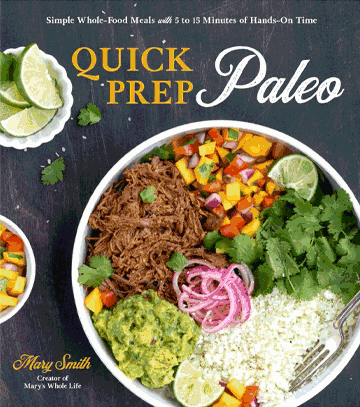
Nutrition
Nutrition information is automatically calculated, so should only be used as an approximation.
Recipe Testers’ Reviews
This recipe totally lives up to its name. The squash made perfect strands. Spaghetti squash will now be a regular veg for us. Why did I ignore it for so long? Less than 5 minutes prep, 40 minutes in the oven, and no additional seasoning needed for delicious squash.
I made a sheet pan-palooza last night with the squash, Brussels sprouts, and sliced shallots, and Za’atar-Rubbed Chicken with Carrots, Beets, and Labne. With 3 pans in the oven, I compromised on the temp and roasted everything at 425°F convection and it all came out perfectly. All in all, a hearty simple meal with leftovers for me to take to work this week.
Roasted spaghetti squash isn’t new, however, this new technique in cutting the squash “crosswise” is a game changer if you want those incredibly long strands that really do look more like spaghetti. The typical approach has always been to cut the spaghetti squash vertically into “boats” to roast them, but the shortish strands it produced didn’t really look like what it was named after. This technique really did produce those long lovely strands allowing this squash to live up to its name! So this new technique is a winner for me!
This simple recipe process was very easy to follow. My 2 lb., 10 oz spaghetti squash was perfectly tender at 40 minutes using the fork test to pierce the skin and the squash easily yielded long strands with the scraping of a fork. A much larger squash would probably take a bit longer.
This truly turned out to be the perfect roasted spaghetti squash.
I also really liked that the cut squash is seasoned with olive oil and sea salt before going into the oven. This gave the squash a really nice sweet flavor.
There are endless uses for spaghetti squash, and I used mine in a shortcut lasagna using the squash as the noodles. Not a vegetarian dish as I also used Italian sausage. So good!
The number of servings will really depend on the size of the squash and its intended purpose. The size of my squash produced 4 cups of squash strands, which would easily serve two people as a main or four people as a side dish.
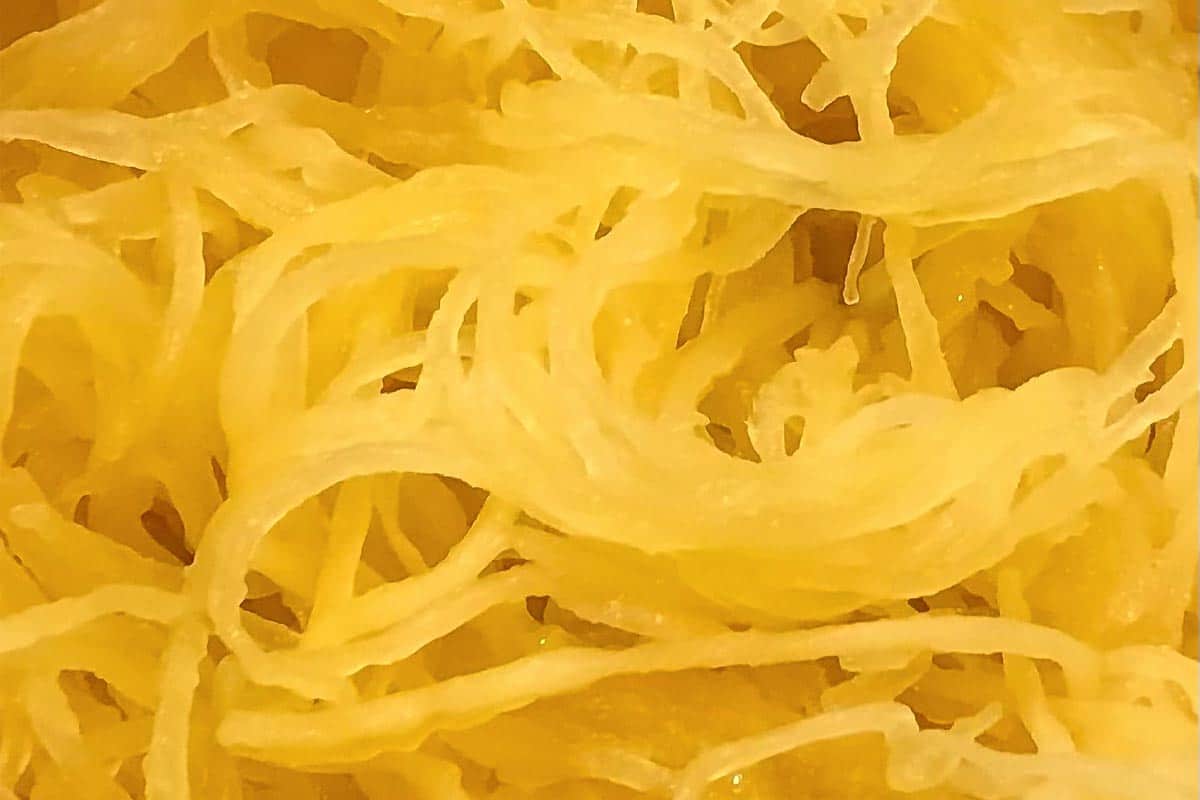
I love winter squash. They can be hard to cut. My favorite part of this recipe was that I cut the squash horizontally versus vertically. So easy and made such a big difference.
After scooping out the seeds, I brushed on the olive oil with a pastry brush. Once it was oiled, I sprinkled 1/4 t sea salt on the cut squash. When I serve the squash, I will add a bit more salt and pepper.
I baked the squash for 45 minutes. The cooked squash shredded easily and in total, yielded, approximately 5 cups of squash.
I never thought to cut the squash horizontally around the middle! It does indeed create longer, spaghetti-like strands. Inverting the squash halves cut side down allows any excess liquid to drain away resulting in great texture. This will become my go-to method. This squash made two perfect servings.
Spaghetti squash is a delicious and healthy alternative to pasta. We like to mix in a small amount of pasta when we eat it with Bolognese, marinara, or meatballs…just to get a little pasta in there but still keeping it light.
This cooking method was a revelation for me! I’ve always found it difficult to cut spaghetti squash vertically down the middle but I was always disappointed with the results when I cooked it whole. Cutting the squash horizontally was so much easier and I loved the addition of salt and olive oil. My husband and I have always enjoyed using spaghetti squash as a pasta substitute when we have spaghetti and meatballs, and this recipe did not disappoint. Now, if only I could have convinced him to share a bowl with me “Lady in the Tramp” style.
The squash easily fell into strands for me, but I think it’s important to make sure the squash is cooked all the way through without it being overcooked. I started testing at 30 minutes and could tell there was still some resistance towards the skin when I pierced the squash with a fork. At 40 minutes, the fork pierced the skin easily but didn’t collapse into the squash. Bingo.
I love spaghetti squash as a side dish or a pasta substitute, but have struggled in the past with cooking it well. This recipe provided me with moist and cooked through squash strands.
I served it in a variety of ways throughout the week: topped with fresh tomato basil sauce, mixed into a Thai papaya salad, and on it’s own with a little extra olive oil, salt, and pepper. It is a versatile dish that can accompany any type of cuisine.
Here’s a hard squash that doesn’t look, act, or taste just like most of the others—an outlier! And a useful one at that.
I baked my squash for 45 minutes until I thought my fork was easily piercing the skin, but I could maybe have baked it 5 minutes less for a slightly toothier, “spaghetti.” And there you are—now what?!
Just a few ideas! The plain Jane approach: salt, pepper, and a little olive oil, as suggested, perhaps with a few fresh herbs atop, basil or parsley come top of mind. Add feta. Toss with pesto. Toss with butter. Top with Parmesan. Toss with brown butter. Toss with vegetables sauteed in oil, or butter, or oil or butter plus garlic. Or toss with roasted vegetables, or roasted vegetables and garlic. Garlic and chili. Mushrooms would be wonderful or mushrooms and garlic. Cacio e pepe with spaghetti squash! Try them with a marinara. Or red sauce and meatballs. Or arrabiata. One of the best features of this recipe is the pro tip to cut the squash horizontally around the equator for multiple reasons, including the one cited, that it creates longer spaghetti. Additionally, it’s a safer and easier cut for a hard squash.
The end result is excellent. Aside from the cutting advice, I see nothing in the recipe that’s unique, but it’s still worth documenting. Fortunately, it’s amenable to refrigeration and reheating.
Not only is this the PERFECT roasted spaghetti squash recipe, it’s the EASIEST spaghetti squash recipe you’ll ever come across. It’s now my official go-to, that’s for sure!
Years ago, when I first started messing around with spaghetti squash, it was always a challenge to cut it in half because I had learned to cut them longitudinally. Due to the increased risk of cutting myself, I switched to cutting a few small slits in it and steaming it whole in the microwave (don’t judge me). I missed the roasted sweetness, but I didn’t want to play “wrestle the vegetable with a knife” game.
With this recipe and cutting it sagittally, I was able to cut through it easily and prep the entire dish in less than two minutes!! LESS THAN TWO MINUTES!! Because the cut side was down, all the water steamed the interior without creating a giant puddle of water. The final result was a bounty of tender, but not mushy, strands of delicious roasted sweetness.
This particular squash weighed 4 lb 6 oz and took 50 minutes to roast. I’m glad I added the extra 10 minutes because it created extra roasted browning and sweetness. I used a Spanish olive oil and sea salt.
The result was about 8 cups of strands. As a side dish you could serve 3 to 4. If you were to serve it with a protein as a main course, I’d say it would make 2 to 3 generous servings.
I plan on having it as a main course with some roasted chicken or a fried egg. Or, I might just have it as a snack right out of the container.
This completely simple treatment may have finally made me a convert to the worthy virtues of spaghetti squash—and now I might owe some folks apologies. My early introduction to it was as a diet-conscious substitute to real pasta was marred by mediocre sauce accompaniment in the 1970s, and more recently I’ve experienced it as a vegetarian dish composed as a too richly indulgent gratin.
It takes less time to wash, cut open and scoop seeds out than it does to warm the oven. Cutting the squash equatorially is brilliant and safe. If getting the oil on the cut rim seems fussy, drizzle it on the parchment or foil and rub the cut sides around in it before you add salt and pepper, then put them back cut side down and pour yourself a glass of wine.
I hereby promise I will never groan at the sight of a spaghetti squash again, now that I know in 30 to 40 minutes I can have the centerpiece for dinner (easier than polenta!) and I can even predict serving a half small one in the shell, securely nested in a deep bowl as the ultimate DIY dinner, with as many possibilities as a baked potato sideboard. But in all honesty, I think it will be a worthy accompaniment to my best stash of Bolognese pulled from the freezer on a busy weeknight (no jarred sauce of my childhood).
At 30 minutes, the squash was a bit too firm, but at 40 it willingly gave way to being progged with a fork and was done. I let it sit for a few minutes and then, holding half in a gloved hand to protect myself from the heat, I easily fork-shredded and scooped the inside of the squash onto the plates.
Here, on its own, simply with olive oil or herbed oil and some salt and pepper, this stood deliciously solo alongside a seared steak finished with mushrooms in a pan sauce. Even as I speared the mushrooms with forkfuls of the stranded squash, I enjoyed the toothsome squash as its own flavor destination. It was deeply satisfying without a carbohydrate coma!
My squash was as small as I could find (under 26 oz) and was perfect for a generous dinner for two. It did take 40 minutes to reach the fork piercing test, and was so simple I felt guilty. I do hereby apologize.
Bonus points—a whole spaghetti sits patiently on your counter or packs perfectly for your staycation or quarantine holiday with even the most primitive oven. It doesn’t even need space in a cooler or fridge til you need it! If you don’t have parchment, use foil!
Giving this a Testers’ Choice is a lot like giving steamed broccoli a Testers’ Choice, but if we consider this a test of technique, then I think it’s a good one. I am a big fan of using spaghetti squash as a substitute for a lot of high-carb pasta dishes. Alone, spaghetti squash is boring, but when enhanced with sauce or seasoning it’s a wonderful vegetable.
This technique was great. I have always microwaved mine but preferred this technique. Mine weighed 2 pounds, 10 ounces and took 50 minutes for the skin to be fork tender. It easily fell into strands and we ate it topped with a vegetarian chili. It could serve 2 to 3 and would work well with any pasta topping. No, it doesn’t taste like pasta, but it’s a great alternative.







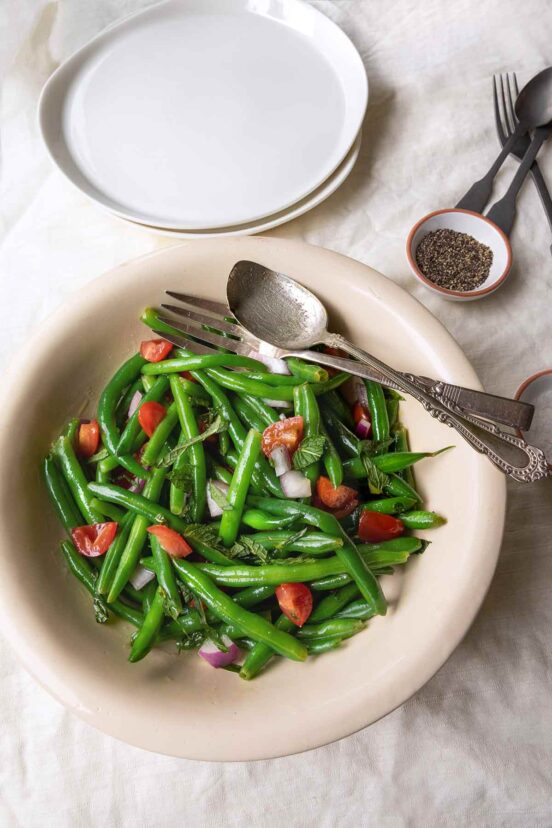
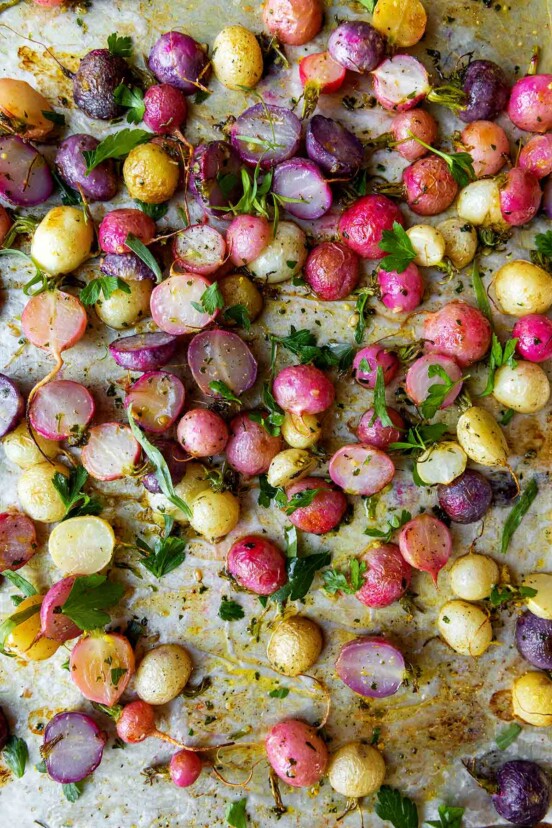
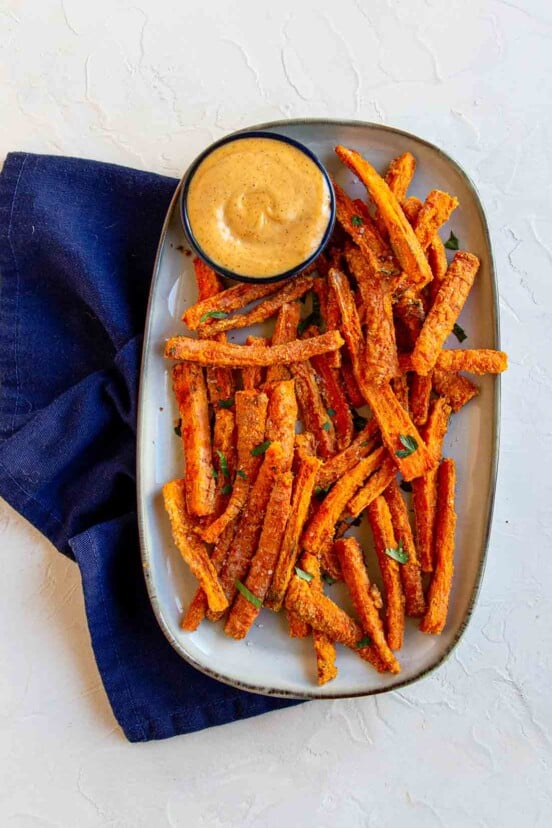









Recipe Tip: When squash was cooked and removed from oven. Set one half in a steep-sided soup/cereal bowl to steady squash as strands were being loosened. Then transferred to cutting board to drag out strands with a fork. Slick!!
Love the tip, Reno Dave! Slick indeed.
Roasted 4# squash, which took 55 minutes. Seasoned with olive oil, kosher salt and black pepper. Very tasty, and with quite long strands. Served with top sirloin steak and green beans.
Reno Dave
Fantastic, Reno Dave! Such a wonderful meal.